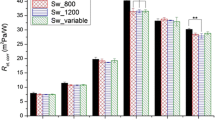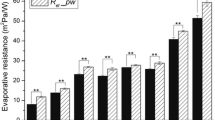Abstract
A moveable sweating thermal manikin has recently been developed. Thermal and water-vapour resistances of three kinds of cold-protective clothing ensembles, laminated with polytetrafluoroethylene, polyurethane and without a laminate were measured, with the aid of the manikin in a cold environment of 5°C with a relative humidity of 70% and an air velocity of around 1.5 m s−1. Two sweating rates of 65 and 130 g m−2 h−1 were employed. Supplied heat fluxes in both of the sweat rates ranged from 350 W m−2 to 400 W m−2. To maintain a comfortable condition, the skin wettedness (w) (mean weighted value) had to be kept at ≤0.6. The measurements obtained from the manikin when testing the three ensembles were w=0.3 (approximately) for the low sweat rate and w≥0.6 for the high sweat rate, irrespective of the property differences among the ensembles. In addition, the condensation in the ensembles in comparison with those calculated from an analytical equation is discussed. Condensation mass fluxes in the ensembles obtained byexperiment and those from the calculation agreed sufficiently well. Thus, distribution of the condensation in the ensembles was estimated using the equation.
Similar content being viewed by others
Avoid common mistakes on your manuscript.
Introduction
A large number of sweating thermal manikins have been manufactured (see Fan et al. 2002; Fonseca 1970) to evaluate the properties of thermal and water vapour resistance in clothing. Most of these manikins, however, have to wear wet knitted clothes and breathable fabric to simulate perspiration and evaporative sweat. A sweating thermal manikin (KEM manikin) has recently been developed by Kyoto Electronics Manufacturing (Kyoto, Japan), which consists of 17 segments and can realise any desired posture thanks to its moveable joints embedded in the body (as shown in Fig. 1). It is not necessary for this manikin to wear additional wet knitted and breathable fabrics because its surface is made of a thick and strong material, which has good water-vapour permeability. Furthermore, 17 sources of sweat are placed beneath the surface material so that a wide sweating rate range (0–1,500 g m−2 h−1) can be controlled independently in each segment by piston burettes.
In this study, simultaneous heat and water-vapour transfer in clothing systems was evaluated using the KEM manikin. In this paper, the amount of condensation and its distribution in the clothes is analysed and discussed.
Methods
Preliminary measurements were made under several environmental conditions to ensure the accuracy of the KEM manikin through the comparison with the results obtained by another thermal manikin (henceforth EVA manikin), which can simulate only heat transfer without mass transfer. In the experiment, environmental temperatures were maintained at 17–25°C with a relative humidity of 50% and air velocities of 0.8–2.0 m s−1. Sweating rates of the KEM manikin were set at 0, 50, 65, 100, 135, 200, and 300 g m−2 h−1. Thermal resistance was calculated from the temperature difference and the sensible heat flux. In the case of simultaneous heat and mass transfer, the sensible heat flux was obtained by the subtracting latent heat from sensible one. The thermal resistances measured by both of the manikins are plotted in Fig. 2 against the air velocity. The one obtained by the EVA manikin is quoted from Fukazawa et al. (2003a). The theoretical resistance based on Holman (1997) is also given in the figure. Both of the results are in good agreement with each other and also with the theoretical one.
Three kinds of the cold-protective clothing were selected for the experiment that had either a laminated microporous membrane of polytetrafluoroethylene (PTFE), a non-porous membrane of polyurethane (PU) or no membranous film at all (NF). The three garments were the same size, although the individual designs differed slightly. These jackets and a pair of quilted trousers were used as the outer layer of clothing. Underneath, the KEM manikin was dressed in underwear consisting of short pants and socks, and a short sleeved shirt and a pair of trousers as the middle layer. The properties of the outer-garment are shown in Table 1. With regard to the experimental conditions, the climate chamber was controlled at 5°C, with a relative humidity of 70% and an air velocity of around 1.5 m s−1. This condition was equivalent to the summit of Mt. Fuji in summer. Two sweat rates of 65 g m−2 h−1 and 130 g m−2 h−1 were employed because these were approximately equivalent to the one during performing stepping exercise with 4–6 Met (e.g. Rissanen and Rintamaki 1997) and with 6–9 Met in a cold environment, respectively.
Results and discussion
In order to evaluate the thermal comfort in the ensembles, the concept of skin wettedness (w) was employed in this study, because it is widely used to express the degree of thermal comfort. According to Havenith et al. (2003), if the skin wettedness exceeds a certain threshold, the body feels damp and discomfort. The threshold depends on the metabolic rate (Nishi and Gagge 1977). This will be called the “comfort threshold” hereafter. In the present experiment, supplied heat fluxes for both of the sweating rates were 350–400 W m−2, corresponding to an oxygen consumption of 1.80–2.05 l min−1 for a young adult male, which is a rather high exercise intensity. The comfort threshold was 0.6 in this condition.
Mean weighted and regional skin wettedness are shown in Fig. 3. In the case of the low sweating rate, the mean weighted skin wettedness for the PU, the PTFE, and the NF ensembles was found to be 0.28, 0.32, and 0.28, respectively. These values did not depend much upon the property difference among the ensembles. Furthermore, since these are much smaller than the comfort threshold of w=0.6, the thermal comfort could be maintained. In the case of the high sweating rate, on the other hand, the obtained skin wettedness with wearing the three types of ensemble was about 0.7, 0.8, and 0.6 for the PU, the PTFE, and the NF ensembles, respectively, which indicates that the comfort threshold was exceeded. Thus, the thermal comfort could be lost in this case.
Measured skin wettedness (w) for the three tested ensembles (NF no film, PU polyurathane, PTFE polytetrafluoroethylene). The numbers on the abscissa mean parts of the body: 1 head and neck, 2 chest, 3 back, 4 pelvis, 5 buttock, 6 right upper arm, 7 right forearm, 8 right hand, 9 left upper arm, 10 left forearm,11 left hand, 12 right thigh, 13 right leg, 14 right foot, 15 left thigh, 16 left leg, 17 left foot. MW indicates mean weighted value of the whole body. The measured MWs were about w=0.3 for the sweating rate of 65 g m−2 h−1 and w≥0.6 for 130 g m−2 h−1. Note that the comfort threshold of the skin wettedness is 0.6 for these experimental conditions
Condensation in the ensembles
If condensation occurs, heat released from the body to the environment is enhanced through the increased heat conduction of the liquid water condensed in the fabric. This causes the discomfort of coolness or cold in low temperature environments. Thus, occurrence of condensation must be avoided for the body to be in thermal comfort.
In order to estimate the condensation rate in clothes, Lotens et al. (1995) and Lotens and Pieters (1995) presented a set of heat and mass balance equations and solved it numerically. More recently, Fukazawa et al. (2003b, 2003c) derived an analytical equation for the condensation rate in clothes, enabling the amount of condensation to be calculated from given conditions of body surface area, clothes and environment. In Fig. 4, the resulting condensation fluxes in the ensembles are plotted against calculated ones obtained using this equation. The condensation mass fluxes obtained from the equation and by experiment agree well, within a tolerable scattering. Differences in the condensed flux among the three ensembles tested was found to be significant for the lower sweating ratebut small for the higher one.
Distribution of condensation
Although the average condensation mass flux could be obtained from the weight gain of the ensemble during the experimental period, it is hard to measure its distribution in the body parts of the ensemble. Thus, an estimation was performed to obtain the distribution of condensation in the ensemble, using the equation derived by Fukazawa et al. (2003b, 2003c). The analysis was based on the measured surface temperature and skin wettedness of the KEM manikin, the properties of the ensemble and the environmental conditions. The results are shown in Fig. 5, where an average for the three types of ensembles is presented. Large amounts of condensation flux can be seen in parts of the trunk (chest, back, pelvis and buttocks), thighs and legs of the ensemble for both sweating rates.
Distribution of condensation mass flux in the ensembles (average of three types of ensembles) using equation of Fukazawa et al. (2003b, 2003c) and measured values such as surface temperature of the KEM manikin. The numbers in the abscissa are the same as Fig. 3. Large amount of the condensation can be seen in the trunk and thighs for both of the sweating rates
Conclusion
Heat and water-vapour transfer through protective clothing has been measured using a sweating manikin. Conditions of thermal comfort can be maintained with wearing any of the tested three ensembles if the sweat rate is less than around 65 g m−2 h−1. For a high sweat rate, such as 130 g m−2 h−1, however, the body would feel discomfort because the heat and mass transfer balance is lost and then a large amount of condensation occurs in the ensemble. The measurement and analysis both indicate that an intensive condensation indeed takes place, especially in parts of the trunk, thigh and leg of the ensemble.
References
Fan J, Chen YS, Zhang W (2002) Comparison of clothing thermal insulation when sweating and when non-sweating. Paper from the 10th International Conference on Environmental Ergonomics, Fukuoka, Japan, pp 589–592
Fonseca GF (1970) Heat transfer properties of ten underwear-outerwear ensembles. Text Res J 40:553–558
Fukazawa T, Tochihara Y, Takahara Y, Tsutsumi K, Lee D (2003a) Combined influence of low temperature and reduced pressure upon skin surface temperature and heat loss (in Japanese). Proceedings of the 48th meeting of the Japanese Journal of Physiological Anthropology, Fukuoka, Japan, pp 42–43
Fukazawa T, Kawamura H, Tochihara Y, Tamura T (2003b) Water vapor transport through textiles and condensation in clothes at high altitudes: combined influence of temperature and pressure simulating altitude. Text Res J 73:657–663
Fukazawa T, Kawamura H, Tochihara Y, Tamura T (2003c) Experiment and analysis of combined heat and water vapor transfer through clothes with condensation. Text Res J 73:774–780
Havenith G, Ueda H, Sari H, Inoue Y (2003) Required clothing ventilation for different body regions in relation to local sweat rates. Proceedings of 2nd European Conference on Protective Clothing, pp 212–217
Holman JP (1997) Heat transfer, 8th edn. McGraw-Hill, New York, pp 299–306
Lotens WA, Pieters AMJ (1995) Transfer of radiative heat through clothing ensembles. Ergonomics 38:1132–1155
Lotens WA, Van De Linde FJG, Havenith G (1995) Effect of condensation in clothing on heat transfer. Ergonomics 38:1114–1131
Nishi Y, Gagge A P (1977) Effective temperature scale for use in hypo- and hyperbaric environments. Aviat Space Env Med 48:97–107
Rissanen S, Rintamaki H (1997) Thermal responses and physiological strain in men wearing impermeable and semipermeable protective clothing in the cold. Ergonomics 40:141–150
Acknowledgements
We would like to express our sincere thanks to Mr. Mutsuhiro Fujiwara, a research technologist of Faculty of Design, Kyushu University, for his helpful technical assistance. Takako Fukazawa gratefully acknowledges the support by the Japanese Society for the Promotion of Science.
Author information
Authors and Affiliations
Corresponding author
Rights and permissions
About this article
Cite this article
Fukazawa, T., Lee, G., Matsuoka, T. et al. Heat and water vapour transfer of protective clothing systems in a cold environment, measured with a newly developed sweating thermal manikin. Eur J Appl Physiol 92, 645–648 (2004). https://doi.org/10.1007/s00421-004-1124-3
Accepted:
Published:
Issue Date:
DOI: https://doi.org/10.1007/s00421-004-1124-3









